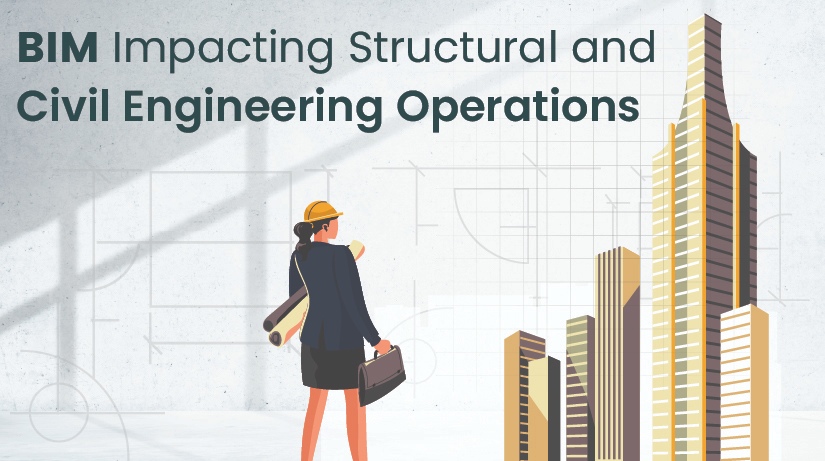BIM Impacting Structural and Civil Engineering Operations
Oct 25, 2023
Category: BIM / Digitization / Automation
SEO TSA

The Architecture, Engineering, and Construction (AEC) industry has already undergone a transformational phase. BIM is the most significant contributor to this paradigm change. The impact of BIM has been extremely high for organizations/individuals involved across different steps/phases of the construction of a building. BIM has not only transformed civil/structural engineering but also assisted engineers with the following:
• Turnkey planning
• Design
• Construction, and
• Ownership and maintenance of a project.
This blog takes a comprehensive look at how BIM impacts structural and civil engineering operations across projects:
Impact of BIM on Civil & Structural Engineering
BIM is called an impetus for civil and structural engineering. This is on the grounds that it resolves many issues connected with efficiency, quality, transparency, and combined efforts. For a great outcome of BIM structural designing and underlying activities, numerous partners need to work together.
BIM provides all those involved in the project with a high level of transparency and capacitates engineers to collaborate in an effective and efficient manner. BIM augments the entire process of engineering by permitting all stakeholders to have more efficiency as well as productivity.
All in all, BIM impacts the engineering part of civil and structural engineering by allowing engineers to:
• Carry out integrated analysis as well as production of drawings for enhanced efficiency in design.
• Bring improvement in communication and coordination between all the stakeholders on account of a central 3D model, and common environment for development.
• Holistically engage all the non-technical stakeholders due to the improved visualization capabilities.
• The betterment in the prefabrication design process is because of a detailed model.
• Execute project planning as well as optimization methodologies based on simulation.
• Drive betterment in budgeting efforts through linkage in all the on-ground activities with ultramodern digital technology-based components.
These are the reasons Plant Design and Certificate Courses are getting immensely popular among civil engineers across the country and the world.
Types of BIM Structural Engineering & Civil Engineering Projects
BIM has proven to be extremely beneficial for a large number of civil and structural projects in contemporary times. Some of the key areas that have benefitted from BIM include the following:
Building Design
BIM helps create a digital representation of the structure or building under designing process and shows how it is going to function.
Infrastructural Construction
BIM in all infrastructural projects helps share all the crucial data electronically with ready access to all involved.
Facility Management Project
BIM models provide comprehensive information about all physical assets of a building, including equipment, systems, and components. Facility managers can make use of this information not only to plan and forecast maintenance activities but also minutely track the lifecycle of each and every equipment and system.
Planning, Operational & Execution
BIM helps in planning, resourcing, and integrating into a project’s execution plan to achieve the value successfully from the available model information.
When it comes to the successful implementation of Building Information Modeling (BIM), different projects have different priorities. This is mainly because different stakeholders aim at things differently in a particular construction project. Based on the nature of the project, BIM has the following applications:
BIM for Building Design & Construction
Building design and construction involve a large number of stakeholders when any project needs to be developed from scratch. Civil and structural engineers involved in the project need to coordinate between numberless services and aspects, all knitted in a single architectural design for accomplishing the construction of a building.
BIM at this juncture helps them facilitate quite smooth and uninterrupted coordination and communication across teams working in the areas of design, engineering and construction. They create a single model not only for better management of all on-site activities and operations but also for eliminating any chances of ill-coordination or any kind of misunderstanding or misconception.
As everybody involved in a project works on a single model, all the possibilities for risks, delays, and reworks get reduced and the overall quality of construction gets better for sure. Building Information Modeling (BIM), in building design and construction projects also helps civil engineers and other stakeholders better optimize the delivery schedule while paving the way for a great handover and overall operations.
BIM for Infrastructure & Facility Management
Infrastructure and facility management contracts are of a more complex and intriguing nature than projects that are developed from scratch. Most of the infrastructure and facility management-related projects involve fine-tuning the utilities, routine maintenance activities, and necessary upgrades.
With BIM, facility managers get better empowered as they are equipped with all crucial pieces of information that are required and needed throughout the entire asset lifecycle. BIM provides better information management as far as supporting asset & facility management tasks are concerned.
Everything important is easily attached to a single model which provides facility managers with an unmatched ease to access the required information as and when they want. There were times when locating any required information used to be a time-killer process because of a tough and complicated paper trail. With BIM, things have become effective and efficient like never before because of the virtualization of assets.
Needless to say, Building Information Modeling (BIM) has brought a never-before revolution in the AEC industry. Its adoption on a large scale in different countries across the globe has opened a new galore of avenues for improved efficiency as well as productivity for the civil and structural engineering segments.
Concluding Remarks
Overall, BIM is expected to grow by leaps and bounds in the coming years. It will create a more open as well as easily accessible environment based on industry standards. Moreover, attention to data relevance and quality will also be the prime focus across all BIM applications. Thus, the widespread adoption of BIM across project teams will be paving the way for more progression in the times to come.








